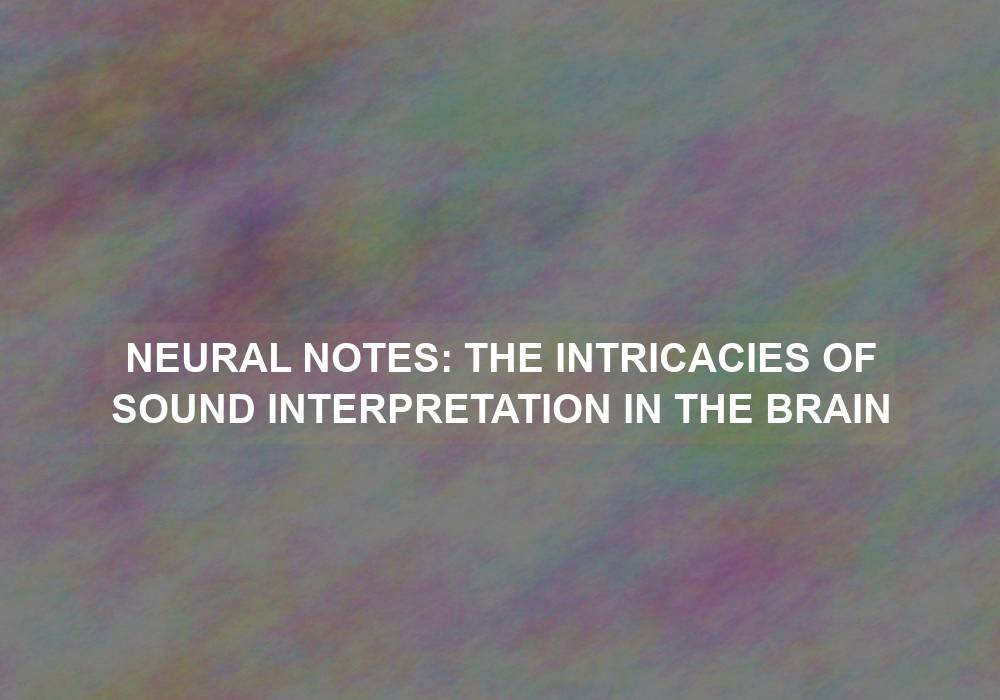The human brain is an extraordinary organ that allows us to perceive and interpret the world around us. One of its most fascinating abilities is sound interpretation. How does the brain process auditory information? What happens when we hear a sound? In this article, we will delve into the intricacies of sound interpretation in the brain and explore the remarkable mechanisms involved.
The Basics of Sound Perception
Before we delve into the neural intricacies, it’s essential to understand the basic process of sound perception. Sound is a form of energy that travels in waves, which are created by the vibrations of objects. When these waves reach our ears, they are converted into electrical signals that can be understood by the brain.
The journey of sound perception begins in the outer ear, where sound waves enter through the ear canal. The waves then strike the eardrum, causing it to vibrate. These vibrations are then transmitted to the middle ear, where three tiny bones called ossicles amplify the sound. From there, the sound waves reach the cochlea, a spiral-shaped structure in the inner ear.
The cochlea, often referred to as the “organ of hearing,” is a remarkable structure that plays a crucial role in sound interpretation. It is filled with fluid and contains thousands of tiny hair cells that are responsible for converting sound vibrations into electrical signals. These hair cells are arranged in rows, with each row responding to specific frequencies.
When sound waves enter the cochlea, they cause the fluid inside to ripple. This movement stimulates the hair cells, which then generate electrical signals. The hair cells in the cochlea are highly specialized, responding to different frequencies and intensities of sound. This allows us to perceive a wide range of sounds, from the softest whispers to the loudest music.
The Auditory Pathway
Once the electrical signals are generated in the cochlea, they travel through the auditory pathway to reach the brain. This pathway consists of a series of neural connections that transmit and process the signals, allowing us to interpret and make sense of the sounds we hear.
The first stop in the auditory pathway is the brainstem, where the signals from both ears merge. From there, the signals travel to the thalamus, which acts as a relay station, directing the information to the auditory cortex in the temporal lobe. The auditory cortex is the primary area responsible for processing sound and is subdivided into different regions that specialize in various aspects of sound interpretation.
Within the auditory cortex, there are different regions that are specialized for specific tasks related to sound perception. For example, the primary auditory cortex is responsible for basic sound processing, such as detecting pitch and intensity. Higher-level regions, like the superior temporal gyrus, are involved in more complex tasks, such as speech comprehension and sound recognition.
Sound Localization
One fascinating aspect of sound interpretation is the brain’s ability to determine the location of a sound source. This process, known as sound localization, involves comparing the slight differences in the time and intensity of sound waves that reach each ear.
The brain uses several cues to determine the source of a sound accurately. These cues include interaural time differences (ITD) and interaural level differences (ILD). ITD refers to the slight delay in the arrival of sound waves at one ear compared to the other. ILD, on the other hand, refers to the differences in sound intensity between the two ears.
By comparing the ITD and ILD, the brain can calculate the location of the sound source. For example, if the sound reaches the left ear slightly earlier and with a higher intensity, the brain can infer that the sound is coming from the left side.
Auditory Processing and Perception
Auditory processing goes beyond simply perceiving sound; it involves the brain’s ability to interpret and make sense of auditory information. This includes recognizing speech, detecting patterns, and understanding the emotional aspects of sound.
The auditory cortex plays a critical role in these complex processes. Different regions within the auditory cortex specialize in various aspects of sound perception. For example, the primary auditory cortex is responsible for basic sound processing, such as detecting pitch and intensity. Higher-level regions, like the superior temporal gyrus, are involved in more complex tasks, such as speech comprehension and sound recognition.
In addition to the auditory cortex, other brain areas also contribute to auditory processing. For example, the limbic system, which is involved in emotions and memory, plays a role in the emotional aspects of sound perception. This integration of different brain regions allows us to have a rich and nuanced experience of sound.
Auditory Disorders and Research
Understanding the intricacies of sound interpretation in the brain is crucial for diagnosing and treating auditory disorders. Conditions such as hearing loss, tinnitus, and auditory processing disorders can significantly impact a person’s quality of life. By unraveling the mechanisms behind sound interpretation, researchers can develop better interventions and therapies for individuals with auditory impairments.
Research in this field is ongoing, with scientists continually exploring the neural pathways and mechanisms involved in sound interpretation. By studying individuals with hearing impairments and conducting brain imaging studies, researchers aim to gain a deeper understanding of how the brain processes sound and develop innovative approaches to improving auditory function.
In conclusion, the human brain’s ability to interpret sound is a remarkable feat. From the moment sound waves enter our ears to the processing that occurs in the auditory cortex, numerous intricate mechanisms are involved. Understanding these intricacies not only sheds light on our perception of sound but also paves the way for advancements in diagnosing and treating auditory disorders. As research continues, we can expect even more insights into the fascinating world of sound interpretation in the brain.
This article was generated with the assistance of OpenAI’s GPT-3 language model.
